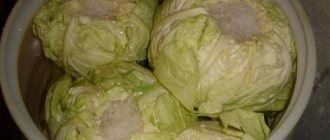How to choose cereal
When most people hear the word buckwheat, they imagine a fragrant porridge of pyramidal kernels with a piece of butter. But this product is also available in other forms, no less healthy and tasty, and you can prepare many more dishes from them:
- Yadritsa - the familiar whole buckwheat kernels from beige to dark brown, steamed under high pressure, suitable for side dishes. Cook for 30–40 minutes.
- Prodel - kernels split into several parts. Cooking time 20 minutes.
- Smolenskaya and flakes - even finer division of kernels into parts. No cooking is required, you just need to pour boiling water over the cereal and leave for 15 minutes.
- Green are unprocessed kernels, they are called live. Green buckwheat can be sprouted or steamed in hot water.
- Buckwheat flour – ground kernels, suitable for making baked goods and drinks.
To choose a product that can be stored at home for a long time, when purchasing you need to pay attention to the quality of the buckwheat presented:
- Choose cereals in transparent packaging so you can see its contents. If there are no black particles or admixtures of other grains, you have good buckwheat. Cereals in original packaging last longer than in bulk.
- The kernels must be the same size, otherwise you won’t get crumbly porridge - some grains will already be boiled, while others will be raw.
- The packaging must be sealed. It is better to choose cereal in a sealed bag, rather than in bulk, as it is guaranteed not to harbor pests until it is opened.
- There should be no musty smell when opening the package.
After purchasing good buckwheat for future use, it is important to properly preserve its beneficial properties and taste.
How to choose the right cereal
In order for buckwheat to be stored for a long time and without additional problems, you should check the condition of the grain at the purchase stage. If the packaging is transparent, you will be able to carefully examine the contents of the package.
The dark color of the grain most likely indicates that the buckwheat was grown in China. This can be checked by studying the information on the packaging. This product is of lower quality due to the high moisture content of the grain. Buckwheat acquires a dark brown color after roasting, and during heat treatment some of the beneficial substances disappear. Another selection criterion is a minimum of impurities in the form of litter, unprocessed grain and small pebbles. If the packaging is opaque, then the type of grain, which must be specified by the manufacturer, will help you determine the quality of the cereal. The first grade cereal is of the highest quality, but the third grade contains up to 10% foreign inclusions and requires mandatory sorting. When examining the packaging, look to see if the GOST number and grain grade are indicated on it.
Please note that, in accordance with regulatory requirements, the “Extra” and “Highest” grades do not exist, and their indication most likely indicates the manufacturer’s dishonesty. If possible, you should smell the cereal. An kernel that smells musty or moldy is obviously spoiled and should not be purchased.
If you discover an unpleasant odor after opening the package at home, you should return the cereal back to the store, like any spoiled product.
Signs of spoiled cereal
The quality of buckwheat is determined by examining several spoons of cereal
Pay attention to:
- color - the grains are covered with a whitish coating or mold;
- smell - mustiness and rancidity appear due to outdated fat;
- taste – buckwheat is bitter if you chew 1-2 grains;
- the cereal falls off, forming lumps;
- living creatures appear - bugs, worms, moths.
These signs indicate that the product is not suitable for food. It should be thrown away.
To check the quality of grain, use this method: grind a spoonful of buckwheat and heat it in a water bath. An unpleasant odor will manifest itself.
If the tests are passed and nothing suspicious is found, it makes sense to cook a portion of porridge and try it.
- Long-term storage of buckwheat is possible if it is initially of high quality. Therefore, when purchasing, you need to carefully consider the product you are purchasing.
- Transparent packaging makes it possible to familiarize yourself with its contents. While the manufacturer often tries to hide a low-quality product in a paper bag.
- High-quality cereals do not contain inclusions: other grains, husks, and various debris. In this case, the grains must be of the same size so that one part of them does not cook before the other.
- Product packaging must be sealed. It should be understood that the shelf life of factory-packed buckwheat is longer than that of loose buckwheat. At the same time, insects will not be able to live in a closed bag until it is opened.
It is advisable to smell the loose cereal. If it emits a musty or moldy smell, it is not advisable to buy it. And in the case when this is discovered at home, after opening the package, the buyer has the right to return the damaged goods to the store with a receipt.
How long do cereals last?
Those who farm will tell you that grain can be stored for a very long time if stored properly. Of course, during long-term storage the taste of cereals deteriorates, but remains quite acceptable. However, most supermarket cereals should be used within a few months of purchase. If cereals are stored in the refrigerator, the period increases slightly, but it hardly makes sense to store cereals for a year or more. Consequently, there is no particular reason for large stocks of flour and cereals if you do not have an equipped place to store them.
Rice and corn do not lose their quality the longest
They can be stored for more than a year, but subject to all the precautions described earlier. Wheat grains, barley, oats and buckwheat store well, but millet quickly becomes rancid
Semolina and flour can be stored for a little more than a year, but in the refrigerator. If you can’t imagine life without strategic food reserves, use airtight containers to store grain, cereals and flour, and inspect your treasures every few months. Replace stale cereals with fresh ones and check for signs of bug infestation.
How to choose
- Long-term storage of buckwheat is possible if it is initially of high quality. Therefore, when purchasing, you need to carefully consider the product you are purchasing.
- Transparent packaging makes it possible to familiarize yourself with its contents. While the manufacturer often tries to hide a low-quality product in a paper bag.
- High-quality cereals do not contain inclusions: other grains, husks, and various debris. In this case, the grains must be of the same size so that one part of them does not cook before the other.
- Product packaging must be sealed. It should be understood that the shelf life of factory-packed buckwheat is longer than that of loose buckwheat. At the same time, insects will not be able to live in a closed bag until it is opened.
It is advisable to smell the loose cereal. If it emits a musty or moldy smell, it is not advisable to buy it. And in the case when this is discovered at home, after opening the package, the buyer has the right to return the damaged goods to the store with a receipt.
How to extend the shelf life of kernels
For a longer shelf life of buckwheat, you can do the following:
- do not store at the top where there is increased heat;
- Before pouring the cereal into a storage jar, place a bay leaf, a clove of garlic, a chestnut fruit, and dry citrus peel - all this will protect the cereal from insects;
- dry the cereal in the oven;
- use only the necessary containers;
- It is better to close it with a non-airtight tin lid so that the cereal “breathes”.
Read here how soon after opening the package you should consume sour cream.
https://www.youtube.com/watch?v=maijkQu7cfY
Now is not the time when you should stock up for future use - you can buy any product on the shelves in the store any day. Therefore, there is absolutely no point in buying packages of 3-5 kg.
A 500 gram package is enough, which you can easily use within a month.
Place, conditions and temperature of storage of sauerkraut
Usually sauerkraut is prepared in large quantities, especially if it is prepared for the winter. Long-term storage of this product is possible only if the appropriate temperature conditions are observed, which allows you to increase the shelf life. The optimal temperature is considered to be from +4 to 0°C. The fermentation process of the product does not stop as long as the air temperature in the room exceeds +10°C, so long-term storage of the product in an apartment at room temperature is impossible.
Important! When storing the product in a warm room without a refrigerator, it quickly peroxidizes and becomes unsuitable for consumption.
You can store the finished product in the refrigerator, but the shelf life in this case will not be as long as in the cellar, since the temperature is usually set at +6...+5°C. If it is possible to adjust the temperature, it is better to set it at +4°C.
Many people are interested in the question of whether it is possible to store the workpiece on the balcony in winter. This is especially true if apartment residents do not have a summer house with cellars, and storing large containers in the refrigerator is problematic. Indeed, a similar storage method can be used on glazed balconies when the air temperature does not fall below 0°C and does not rise above +8°C. If, in severe frosts, the balcony freezes, then the container must be placed on an elevation and a multi-layered shelter of warm clothes must be provided.
In addition to the air temperature in the room in which the finished product will be stored, the level of air humidity and lighting intensity are taken into account. The container must be protected from direct sunlight, as the finished product can quickly deteriorate. Air humidity for normal storage of workpieces should be increased, optimal values are 85–95%.
Did you know? Sauerkraut is much healthier than fresh cabbage; during the fermentation process, it retains all the beneficial substances and is also enriched with organic acids - acetic and lactic.
The essence of GOSTs
General tech. conditions for buckwheat comply with the requirements of GOST R 55290-2012, SanPiN 2.3.2.1324-03. GOST provides various regulatory physico-chemical, as well as organoleptic indicators, which make it possible to determine the product’s compliance with the requirements of the standards, as well as labeling rules.
Thus, clause 6 of GOST R 55290-2012 states that the packaging must contain the following information, in addition to weight, grade, etc.:
- production date, not only the year, but also the month;
- best before date.
In clause 11.7 of the same GOST, responsibility for determining the shelf life of buckwheat cereals rests with the manufacturer.
Here are the shelf life limits for the product:
- kernel - 15-20 months;
- completed - 14-18 months.
The decisive factor in determining the shelf life of the manufacturer is the content of acidic fat in the cereal.
According to the hygienic requirements regulated by SanPiN 2.3.2.1324-03, buckwheat is not a perishable product, but clause 1.6 of this document speaks of the need for the entire period of transportation, storage and up to the date of sale to comply with optimal physical parameters - temperature, humidity, etc. ., otherwise the cereal may become unusable before it falls into the hands of the consumer.
These regulations prescribe technical requirements for the composition of buckwheat, so GOST R 55290-2012 defines:
- its chemical composition;
- physical parameters;
- organoleptic indicators – color, smell;
- marking.
In accordance with clause 11.7 of this GOST, it is stated that determining storage periods lies with the manufacturer.
Thus, for the core, the deadline is 20 months, for the product - 18.
Sanitary and hygienic requirements in SanPiN 2.3.2.1324-03 define buckwheat as a non-perishable product.
Clause 1.6 regulates the rules and procedures under which buckwheat should be stored and transported until it falls into the hands of consumers.
More details about the storage regime and periods are described in paragraph 11 of GOST R 55290-2012, which specifies temperature parameters and air humidity indicators.
So in paragraph 11.5 of this document it is written that the humidity should be no more than 70%, otherwise the shelf life is reduced.
How long does boiled buckwheat last in the refrigerator?
How to cook buckwheat (buckwheat). How to cook millet correctly, how long to cook millet porridge. In this place, buckwheat is stored for up to 3 days. Boiled buckwheat porridge is placed in portions in plastic bags or plastic containers in the freezer compartment. How long does it take for buckwheat to spoil in the refrigerator? Crumbly buckwheat porridge cooked in water is stored in the refrigerator for five to six days. As for storage, we once had boiled buckwheat in the refrigerator for 10 days. To this day, buckwheat is the most popular cereal for the Russian-speaking population. How long can you store boiled buckwheat in the refrigerator? Track. How long can boiled buckwheat last in the refrigerator? Oh, for some reason we keep Easter eggs at all times. I’ll be traveling on the train for more than a day, so I was thinking about what to take from healthy food, I thought about buckwheat, but how long will it last on the train without a refrigerator? You shouldn’t take boiled foods. > How many days can boiled buckwheat be stored in the refrigerator? refrigerator boiled buckwheat. How long can boiled buckwheat be stored on the balcony: at temperatures above 0 C up to 3 days, at temperatures below zero up to 57 days. This page contains materials on the request of how long boiled buckwheat can be stored in the refrigerator. How long cooked food can be stored in the refrigerator. Boiled buckwheat can be stored in the refrigerator for up to five days. How long does buckwheat last? - Boiled buckwheat. Do not store in the refrigerator! The optimal temperature is 20-25C. How many days can goat molokone from the store be stored in the refrigerator, and does it need to be boiled to prolong the life of XP. How to store buckwheat correctly.
Buckwheat can also be stored in the refrigerator. House. How long can boiled buckwheat be stored in the refrigerator? |The only thing is that if the pan is not too airtight, it will certainly absorb extraneous odors over such a long time. Already boiled buckwheat can also be stored in the refrigerator.
Top articles: How to store bee bread at home: how much and how to dry it correctly
Storage conditions for boiled buckwheat
There are general rules on how to properly observe the storage regime for this cereal.
Clause 11 of GOST R 55290-2012 provides the values of air indicators in the rooms where cereals will be stored. The temperature in the house or apartment should not exceed 25°C.
The maximum air humidity recommended by clause 11.5 of GOST R 55290-2012 is 70%. If the humidity is above 70%, then the cereal should be protected by placing it in another room.
Regulatory documents do not regulate the level of illumination: lighting does not play a special role for the preservation of buckwheat.
Clause 7.3 of GOST lists the types of consumer packaging where it is permissible to place cereals when packaging them in production, which allows you to store the product in the following containers at home:
- paper bags;
- cardboard packs;
- bags made of food polymers (polyethylene, polypropylene, polyvinyl chloride).
The use of other containers is not prohibited - glass or plastic jars with lids (provided that the plastic is intended for food products).
The manufacturer also ships grains in canvas bags, so at home you can easily pour the grains into a fabric bag (if there are no rodents).
Clause 11.6 of GOST states that it is unacceptable to contain buckwheat along with goods that have a specific odor. For example, if there are cans of paint and cans of gasoline in the pantry or garage, then you should not keep cereal there - the product will become saturated with unpleasant odors.
On store shelves you can see buckwheat in different packages, different weights, prices and composition.
To extend the consumption of an open package of buckwheat over a longer period, you must follow the storage rules:
- light does not play a special role;
- You need to pour the cereal into plastic, paper, polymer, glass, cardboard containers.
If you choose polymer or plastic jars, they must be designed for storing food.
The shelf life of buckwheat is directly related to its original state. Therefore, when buying cereal, you need to pay attention to a number of important points.
- Packaging. It is better if it is vacuum and, of course, intact. Hermetically sealed kernels are stored for 15 to 20 months. Duration – 14-18 months.
- Date of filling and packing. Typically, this data is stamped on the seam of the package by the manufacturer. If information about the production time of a product is contained on a paper label pasted by the seller, there is no confidence in the reliability of the information.
- Presence of insects. Even factory-packed buckwheat sometimes gets moths and bugs. The likelihood of finding them in bulk products is even higher.
- Mold. If the grains are covered with a whitish coating and emit a characteristic musty smell, the buckwheat was stored in a humid environment and it has become moldy.
How long can boiled buckwheat be stored? This depends on the composition of the porridge and the place in which it will be located after cooking.
At room temperature, buckwheat cooked in water can remain fresh for 24 hours. Porridge cooked with the addition of meat, butter or milk - from 4 to 8 hours.
Buckwheat porridge can be stored in the refrigerator for much longer. If it contains nothing but salt and water, it will stay fresh for 3-5 days in a covered pot. Buckwheat with butter or meat will not spoil for three days. Milk porridge should be eaten within 24 hours.
In the cold season, porridge (except milk) can be placed on the balcony. At sub-zero air temperatures, it will remain usable for three days.
Porridge should not be consumed if the following signs of spoilage appear:
- sour smell;
- slime at the bottom of the pan;
- green or black mold on the surface.
If there is still some cooked buckwheat left, and its shelf life is coming to an end, the freezer will help protect the product from spoilage. The porridge is placed in portions into plastic containers intended for freezing, sealed hermetically and sent to the freezer. The shelf life of frozen boiled buckwheat will increase to 2 weeks, but this will not have the best effect on its nutritional value.
If there is no special container, you can put the porridge in the freezer in plastic bags. In this case, each portion should be packed in 2-3 bags, placing them one on top of the other. A triple layer of cellophane will protect the product from unwanted odors.
Thus, storing raw and cooked buckwheat at home is easy. If you prepare the “correct” container, observe the temperature regime and periodically check the product for spoilage, its shelf life will be maximum.
Storing green buckwheat
Nowadays, when healthy eating is very important, eating green buckwheat is becoming increasingly popular. But this raises a new problem - how to store green buckwheat? After all, it is not subjected to heat treatment, like brown cereals.
The taste of green buckwheat is reminiscent of nutty, while it contains a large amount of minerals and vitamins, but requires certain storage rules.
Places for storing green buckwheat should be dry and cool. Bright light can negatively affect the consumer qualities of this product. Therefore, cereals should be kept in a dark cupboard or pantry.
To prevent the bulk product from becoming covered with mold and acquiring a musty smell during long-term storage, it is better to keep it in a linen bag where it can “breathe.”
Cooking tricks
To prepare not only healthy porridge, you need to know a few little tricks:
To keep buckwheat as healthy as possible, you should not expose it to prolonged temperatures when cooking. It is best to cook buckwheat porridge over low heat;
You should not cook buckwheat in milk. If you want milk porridge, then do not boil the cereal completely, then add milk and let it brew. This will allow you to retain more nutrients;
You should not add honey or sugar to the porridge, as this will sharply reduce the benefits of consuming it;
To make the porridge tasty, you can add a little butter;
Buckwheat porridge goes well with vegetables and fruits, which can be added to the porridge to diversify the dish and improve the taste.
What should you pay attention to when buying buckwheat? First of all, on sealed packaging, since this factor significantly affects the shelf life of buckwheat. Moreover, it is desirable that the packaging be cellophane, then the buckwheat will be dry and without moisture
It is necessary to pay attention to the color of buckwheat. If it has a reddish or dark brown tint, then most of the beneficial qualities of the cereal have already been lost due to steaming. But the cream color indicates that the buckwheat was not steamed and retained all its most important properties.
Some people mistakenly believe that the shelf life of buckwheat is unlimited. This is far from true.
Subsequently, buckwheat begins to lose its beneficial qualities, as well as its taste.
It is highly recommended to store buckwheat in cool and dark places. The best option would be a well-sealed jar, since the tightness has a positive effect on the shelf life of buckwheat. Before this, it is best to sift the buckwheat and only then place it in a certain container.
Shelf life of buckwheat in the refrigerator
Buckwheat can also be stored in the refrigerator. To do this, it is recommended to pour it into a glass jar and close the lid tightly. It is highly undesirable to store buckwheat in the refrigerator in a plastic bag, otherwise the cereal will quickly spoil.
As for cooked buckwheat, its shelf life in the refrigerator is only three days under favorable storage conditions. To prolong the freshness of porridge, follow simple rules:
If you plan to store porridge in the refrigerator, under no circumstances add butter, meat or milk to it;
The optimal temperature for storage in the refrigerator should be between +2 and +4 °C;
How long can buckwheat stay in the refrigerator?
Boiled cereal will not spoil if it sits in a saucepan in the refrigerator for a week. If it turns sour, it acquires a taste and smell, which immediately makes it clear that it’s time to throw away the food. But are the beneficial qualities of porridge preserved after 7 days?
The answer is no. After a week of keeping the porridge in the refrigerator, it can suppress the feeling of hunger, but will not bring any benefit. In order for all the vitamins and minerals to enter the human digestive system, you need to eat buckwheat porridge, which has been left in the refrigerator for no more than 2 days. This is its shelf life. The optimal temperature for keeping cooked cereal is +4 degrees.
Storing food in containers
If the porridge has just been cooked, you should not put it in the refrigerator while it is hot. But you need to know that boiled buckwheat can be stored without refrigeration for no more than 3 hours. The higher the ambient temperature and the higher the humidity, the shorter the time during which you can keep the porridge in the room.
How long can boiled buckwheat be stored in the refrigerator?
This dish, as we noted above, also has its own shelf life. In other words, ready-made porridge can be stored, but only for a limited time. There are several different options here. In particular, you should store boiled buckwheat:
- on the balcony;
- in the freezer;
- in a refrigerator.
It is clear that the first option is only suitable for the cold season
After all, temperature is important here. In particular, buckwheat porridge can be stored on the balcony only if the thermometer does not rise above +4 degrees
In such conditions, the porridge will last up to 3 days. If the temperature drops below zero, the shelf life of the product increases to 7 days.
Another possible storage option is the freezer. It is advisable to place boiled buckwheat there in containers or bags. This option has a long shelf life of 3-4 weeks. We take out the buckwheat as needed and heat it in any convenient way. All this time, the product will retain all its beneficial properties and taste.
However, the most convenient option for storing boiled buckwheat is the refrigerator. After all, the product no longer needs to be defrosted. This means you won't waste extra time. True, buckwheat can also be stored in the refrigerator for not very long - up to 3 days, just like on the balcony at sub-zero temperatures. But here this can be done all year round, and not just in the cold season. Most housewives choose this option. As a rule, buckwheat placed in the refrigerator is eaten the very next day. In terms of taste and usefulness, it is only slightly inferior to freshly prepared.
If you decide to store boiled buckwheat in the refrigerator, be sure to place it in a tightly sealed container. Recommended temperature: +4 °C. In no case should you add perishable foods - meat, butter, milk, etc. - to a container with boiled buckwheat. It often happens that the stock of product sent for storage is quite large. In this case, there is no need to heat up all the buckwheat. Take out of the refrigerator as much as you need right now, and put the rest back. And try to get the required portion as quickly as possible.
It should be noted that if you store boiled buckwheat on the balcony or in the refrigerator, it is recommended to regularly monitor the condition of the product. There are several signs here that clearly indicate that the porridge has already begun to deteriorate. The most obvious one is mold. As soon as you notice it, throw the product away immediately. Such buckwheat already poses a serious threat to health. Also an alarming signal is the appearance of mucus at the bottom of the container in which buckwheat is stored. It's better not to risk it and throw the product in the trash. Another warning sign is a sour, unpleasant aroma. Even a slight unpleasant odor is a reason to stop storing and throw away the product.
As you can see, the rules for storing boiled buckwheat are not very complicated. The main thing is that the product does not sit in a warm place for a long time. In addition, boiled buckwheat quickly deteriorates due to high humidity. Accordingly, for long-term storage (at least several days), it is imperative to exclude the influence of these two factors. Therefore, what you could not eat right away, it is advisable to place it in the refrigerator, freezer or take it out to the balcony as quickly as possible. At room temperature, porridge will not last long.
Of course, the most delicious and healthy food is freshly prepared. But situations, as noted above, are different. Sometimes you need to cook buckwheat for future use. Knowing how to properly store this product, you can easily keep it in edible condition for several days. If necessary, the product can be put in the freezer - this will be a kind of strategic reserve. It will always help out in situations where there is no time to cook or simply no energy. After all, here you just need to take the buckwheat out of the freezer, defrost it and heat it in the microwave or some other way.
08 Jul 2021 edypravilno 107
How long does cooked buckwheat last in the refrigerator?
Of course, any culinary specialist will say that it is much tastier to eat fresh, just cooked porridge. But it happens that after a meal there are food leftovers and they can and should be stored, shouldn’t they be thrown away right away? If you are a porridge lover, you will be interested to know how long boiled buckwheat lasts in the refrigerator.
If you put the porridge in the refrigerator, it is advisable to eat it within two days from the moment of preparation. But at high temperatures, especially indoors, the freshness of the porridge will remain for a couple of hours.
Some housewives are now surprised, because it happens that porridge can retain its freshness for a week. You can eat it, but the benefit will be zero. The longer boiled buckwheat sits in the refrigerator, the less beneficial properties it will retain. You can simply satisfy your hunger.
The component composition is preserved for 48-72 hours from the moment of preparation. And if you have added any additional products, then it is better to consume buckwheat porridge the next day at most.
Buckwheat porridge can be left on the balcony during the cold season. It is important that the dish is not exposed to sunlight.
On a note! The optimal temperature for storing cooked buckwheat is considered to be +4°.
By the way, buckwheat porridge can even be placed in the freezer. If frozen, the prepared treat will be stored a little longer and will retain all its usefulness. You just need to defrost the porridge, heat it up and serve it. The taste will remain virtually unchanged.
How to store buckwheat correctly
Buckwheat is a very healthy product and is available in almost every kitchen. However, you should know how to store buckwheat so that there are no bugs in it, so that it does not become moldy or evaporate.
After purchasing a bag of buckwheat, it should not be left in it, but should be poured into another container. This needs to be done because the plastic bags in which cereals are now sold are not at all suitable for long-term storage, since the cereal in them may be prohibited, the bag may tear and the buckwheat will have to be either collected or completely thrown away.
If you have a lot of cereals, then before storing them for long-term storage, you need to dry them in the oven.
You can take note of your grandmother’s recipe for storing cereals. To do this, take a linen bag and boil it in a strong saline solution. Dry. This method is good because the fabric packaging will not allow the cereal to “suffocate”, and the salt will not allow mold and bugs to appear.
You should also take into account that cereals usually absorb various odors well, therefore, for long-term storage, place buckwheat in a place where this does not happen.
Top articles: Storing cauliflower at home
How to store dry buckwheat
Dry buckwheat can be stored in a cool, dry, dark place for approximately two years. If conditions are far from ideal, then you can keep buckwheat on the shelf for up to a year. Further, it will lose both its beneficial properties and taste. However, the situation is the same with pasta and other cereals.
By the way, if you are going to cook buckwheat, do not forget to rinse it with water 3-4 times. If you stored it in an unsealed container, then there may be bugs and other living creatures in it. Also, when packing buckwheat, there may be twigs and any other debris in the packs.
How long and correctly can buckwheat be stored?
Each food product has its own shelf life, and buckwheat also has one. If all standards are followed, this product can be stored at home for 2 years. But it’s better not to let it reach this point and consume buckwheat a year after purchase.
In domestic stores you can find the following types of this product:
- kernel (traditional type of buckwheat);
- green (not thermally treated);
- prodel (grains separated from the shell).
For any of these types, there are general rules for storing at home:
- The place should be dark and cool.
- The container should be tightly closed.
- You can’t keep cereal in plastic, it will quickly become unusable.
Did you know? According to research by modern scientists, this grain crop emits a certain aroma that improves sleep. Its husk is used to fill pillows, which should be purchased by people suffering from insomnia.
Dry
After purchasing regular dry buckwheat, you must first sift it and then transfer it to a container with a hermetically sealed lid.
It could be from:
- glass;
- metal
If the cereal is wet - this happens when it is contained in plastic packaging - it must be dried in the oven before pouring into the container. But the temperature regime should be set to a minimum, since under strong temperature influence the cereal will lose most of its beneficial properties. You can also freeze-dry buckwheat by leaving it in the freezer for a day.
The following can help against the attack of various pests that love to settle in cereals:
- several cloves of garlic;
- Bay leaf;
- horse chestnut;
- lemon peel.
By placing these substances on the jar, you do not have to worry about attacks from small pests. Cereals can be stored in linen bags, previously boiled in salt water. In such conditions, the cereal does not rot, and the salty smell will drive away harmful insects.
Green
When storing green buckwheat, you should follow a number of simple rules:
- The place in which the container will be kept must be dry - moisture will destroy the grain ahead of schedule.
- Green buckwheat should be protected from sunlight; in the light it darkens and becomes bitter.
- The product must breathe, so a canvas bag is the ideal container.
Important! Even unspoiled buckwheat porridge, consumed the next day, will by that time lose a number of beneficial properties, so it should be eaten immediately and not cooked for future use.
Boiled
Cooked porridge can stand in the refrigerator for no more than 3 days.
But even in this short period of time, a number of rules must be observed:
- The product must be cooked in water, without dairy, meat or any other additives.
- Storage temperature should be +3…+4°С.
- The container with porridge must be well closed, as this product quickly absorbs the aromas of other dishes.
In open or closed packaging
After purchasing, the product should be immediately removed from the packaging and poured into a glass or tin container. You can’t store it in plastic - there the cereal will quickly dry out and lose its beneficial properties. In a humid environment, harmful insects will immediately appear and completely ruin the buckwheat.
Important! Even if the cereal is purchased in a sealed package, it must be rinsed with cool water before cooking. This will improve the taste of the dish.
How much and how to store raw cereals
The shelf life of buckwheat depends not only on the initial quality of the product, but also on the conditions in which it is placed after purchase. In sealed factory packaging, the kernel remains usable for 15-20 months. Duration - from 14 to 18 months.
After opening the package, the kernel must be eaten within 4 months. The lifespan was 3 months.
It is quite possible to preserve the properties of buckwheat throughout its shelf life if the following conditions are met:
- Buckwheat purchased by weight should be immediately transferred to a container made of glass, metal or food-grade plastic with a tight-fitting lid. Or put it in a canvas bag with drawstrings. If the cereal was sold hermetically sealed, it should be poured into a suitable container immediately after opening. It is not recommended to keep it in a plastic bag for a long time. In such a container, especially at high humidity and temperature, it will “suffocate” and go rancid.
- Place the bag or container of cereal in a dark pantry or closet. It is not recommended to store jars of buckwheat in the light. In hot weather, condensation may form in them and the kernels will go rancid. The optimal temperature for storing the product is 5-25°.
Nutrients are fully preserved in buckwheat for about 8 months. After 12 months cereals lose them almost completely.
For fans of healthy eating, they sell green buckwheat, which is not boiled, but sprouted and steamed with boiling water. This product can be stored in packaging for 15 months; if opened, it does not lose its beneficial properties for 2 months.
The main “enemies” of buckwheat are dampness and insects. How to deal with them?
- If the humidity in the room where the cereal will be stored exceeds 60-70%, it is better to dry the kernels additionally. This can be done by laying them out in one layer on a baking sheet and placing them in an oven preheated to 160° and turned off for 10 minutes.
- To prevent the kernels from becoming damp, they are placed in dry linen bags, boiled in a concentrated saline solution (130 g of salt per 3 liters of water). If the cereal is poured into a jar, before placing it, place a small bag of thin cotton or gauze filled with salt on the bottom.
A few bay leaves or unpeeled garlic cloves will keep insects away from the cereal.
Buckwheat should not be stored next to coffee and spices. The cereal will absorb the odors of these products and will be tasteless after cooking.
Can I use expired food?
Expired cereals can be consumed if no unpleasant odor, taste or other negative factors are detected.
However, it’s hardly worth risking the health of your loved ones, so when buying grains you need to take the time to study the packaging and make sure that the buckwheat is not expired.
Porridge will be tasty and healthy when made from fresh cereals. Creating reserves in order to constantly eat food from products that have expired or are at the limit is, to say the least, unwise.
It makes more sense to buy even more expensive, but light-weight cereals in factory packaging, where the expiration date is printed on the package by the manufacturer.
You can learn how to choose good buckwheat from the video:
Didn't find the answer to your question? Find out how to solve exactly your problem - call right now:
Bush storage
The gardener knows that each flower requires special treatment.
How to preserve seedlings correctly? In order for a flower to bloom long and brightly, proper care is not enough for it; careful storage is also important. If you don't dig up a rose seedling and leave it in cold soil, it may not die, but it won't bloom.
Therefore, it is necessary to allocate a place for proper storage of roses in the winter in the basement or refrigerator.
Preparation
You can save bushes from freezing if you make preparations in time, which begins at the end of September or after the first cold weather. Each shoot must be cut so that a branch of about half a meter remains above the soil.
The older the bush, the more you cut. Counting the buds that remain on the plant will help prevent mistakes; there should be at least eight of them. Remove all remaining leaves from the bush and tie the branches with rope. Treat the plant with special agents to prevent infections.
You need to dig up bushes before frost
Bushes should be dug up when the first light frosts appear, when they reach -2°C at night, in dry weather. In wet weather, it is difficult to clean the roots from lumps of dirt. If it was not possible to dig up in time and the bushes remained too wet, they need to be dug up and placed to dry in a warm place for a couple of days so that excess soil can be removed. When transporting bushes (if the storage location is far away), they must be tied with twine to keep the branches intact.
Storage in a container
To store seedlings, use any plastic container of a suitable size.
You can use special containers or plastic buckets to store seedlings. Place bushes, one or several, in each separate container so that they are close to each other. Fill the free space with soil and fertilizer. While performing this procedure, the bucket should be shaken periodically so that the soil settles tightly and completely covers the roots. Then fill everything with water. This option is suitable for those who plan to move rose bushes.
Some gardeners are sure that flowers should be stored in sand, as it retains moisture longer and maintains a constant temperature, which prevents the rapid growth of plants. Organization of preservation is carried out using the same method as with soil.
Storage on racks
Wash and dry the roots of seedlings thoroughly before storing.
A basement that has special shelving to store plants does not require containers with soil to be brought in. To prevent the formation of diseases and the process of rotting, the racks should be thoroughly washed and dried before laying.
Cover the shelves with wax paper and place the seedlings on it. Several times a month, inspect and spray the roots with water if drying is noticed.
The room humidity should be 90-95%, and the temperature +2 - 0°C. Such a climate will help the plants stay sufficiently hydrated and also retain all the necessary properties. If the temperature rises to +5, the seedlings can germinate and bud. It must be lowered, water the roses with cold water or bring ice into the cellar and place it next to the bushes. Ice or snow should not be allowed to get between the bushes, as they will immediately begin to mold. For more information on how to properly store seedlings in winter, watch this video:
https://youtube.com/watch?v=TdJ4VY0aCvw
Also, temperatures that drop to -1°C should not be allowed. This can cause the ground to freeze and the roots will disappear. It is better to immediately increase the humidity and cover the plants with film or other insulation. After signs of warming appear, remove the film.
Flowers are stored well in a dry, clean and well-ventilated area.
In a refrigerator
Store seedlings in the refrigerator at the correct temperature
Why is it necessary to store roses in the refrigerator? In winter, when the constant temperature on the balcony exceeds -5°C. But, before placing the branches there, you should check whether the appropriate mode is set. After making sure that everything is in order, pack the prepared seedlings in plastic bags, but do not tie them or pull them too tightly so that the plant can breathe.
Storing seedlings will be correct if the plants are placed close to each other on the shelves. Check for moisture and mold once a month. If there is a need, spray with water from a spray bottle and remove any mold that appears. Useful video about storing seedlings:
Rules
To preserve the taste of cereals as much as possible, you must adhere to the rules presented below.
- Be sure to pour purchased bulk products into special food containers.
- The storage location should be dry and dark, with good ventilation.
- Optimal storage conditions are temperature from –5 to +5 °C and humidity 60–70%. Make sure that the maximum temperature does not exceed +18 °C.
- Do not keep strong-smelling foods (smoked meats, spices, etc.) near cereals.
Top articles: What is the best way to store apples after drying?
Optimal flour storage conditions
How to properly store yeast?
Methods for cleaning stainless steel spoons and forks
Shelf life of buckwheat in packaging
The freshness period of cooked porridge and the packaged product are different. Hermetically sealed packaging and the quality of the cereal itself help keep the cereal in good condition. Buckwheat is stored in packaging for two years. Moreover, it will stand on shelves in a room where it is dark, cool and dry. Leaky packaging threatens the appearance of bugs, insects and debris in the cereal.
At temperatures from +5 to +15 degrees, the freshness of the porridge corresponds to that indicated on the package; if the sun's rays enter or the room temperature differs from the desired one, the buckwheat spoils earlier. Buckwheat quickly deteriorates when exposed to moisture. Mold and mildew appear. So the humidity in the room is kept within 60%.
After purchasing the product, you should take for storage not the packaging, but a tightly closed container or tray, jar with a lid. It is necessary to ensure that sunlight does not enter the storage area, as it quickly spoils the products.
Buckwheat is a healthy food product that retains its beneficial properties throughout its shelf life. It has the properties of a natural antioxidant and reduces cholesterol levels in the body. At the same time, cereals should not be stored near household chemicals; they quickly absorb odors and impurities from the air.
Video: Elena Malysheva. How is buckwheat useful?
Watch this video on YouTube
Video: Buckwheat benefits and harms. Buckwheat calorie content, how to cook and cook correctly
Buckwheat benefits and harms. Buckwheat calorie content, how to cook and cook correctly
Watch this video on YouTube
Do you want to understand better than others?
- How long can corn be stored in the refrigerator and without it - Corn is a cereal crop, although many perceive it as a vegetable due to its frequent use in preparing salads. The sweetness of boiled cob grains is very...
- Shelf Life of Cooked Rice in the Refrigerator - Rice is one of the most common grains used in the daily diet and in some holiday dishes. The finished product contains many...
- Terms and rules for storing kefir in the refrigerator - The duration and rules for storing fermented milk products are regulated by strict requirements, since the presence of active compounds in such items limits the period...
- Shelf life of churchkhela in the refrigerator and at room temperature - Churchkhela is gradually becoming one of the most popular Georgian sweet dishes. This delicacy is known all over the world. Churchkhela are nuts that are strung on a dense thread...
- Terms and conditions for storing raw and processed meat in a household refrigerator - Meat products are a necessary part of the human diet. They contain many vitamins, macro- and microelements, as well as other substances without which the human body cannot…
Prevention of black bugs
In order to prevent the appearance of bugs in cereals, observe the following preventive measures:
- Carefully inspect the product when purchasing for the presence of pests and the tightness of the packaging;
- observe the expiration dates of cereals and do not make large purchases in reserve;
- Store products in sealed, separate containers. The ideal option is glass containers that allow light to pass through and protect from moisture;
- periodically audit your supplies and throw away those that are in doubt;
- maintain cleanliness and order in the kitchen, prevent high humidity in the room;
- place pest repellers next to the cereals - garlic, bay leaf, nutmeg;
- Before cooking, check the grains and do not forget to rinse them well.
To store cereals at home, use glass containers with a hermetically sealed lid.
This will prevent the appearance and proliferation of pests. You can get rid of bugs in cabinets and in the kitchen yourself, using proven folk remedies and achievements of the chemical industry
At the same time, it is important to get rid of the source of infection, carry out general cleaning in the kitchen and audit supplies
In order to avoid problems in the future, follow preventive measures, pay special attention to the quality of the cereals you buy, their shelf life and storage rules
How and for how long to store buckwheat correctly
Thanks to the mass of useful substances, buckwheat is one of the healthiest cereals. It contains trace elements of iron, phosphorus, iodine, cobalt, copper and zinc. The content of organic acids – citric, malic, maleic, oxalic – is also one of the highest.
In addition, all vitamins, including such essential ones as B, P, PP, are balanced in quantity. Very often, the price of buckwheat fluctuates significantly depending on the season, so many people want to stock up on this product.
To prevent buckwheat from disappearing, you need to know how to store it correctly.
How to properly store buckwheat
When storing buckwheat, it is necessary to maintain a temperature no higher than 18 °C.
In order for buckwheat to be stored for a long time at home, it must be stored in a dry container, in a dark place and protected from bugs. Humidity allows mold to develop, and bugs spoil the cereal, giving porridge from such cereal a specific bitter taste, so this buckwheat is only suitable for the trash can.
https://www.youtube.com/watch?v=MXluu9PswY4
Buckwheat should be stored correctly in a dry glass or plastic container with a tight lid. A metal jar without scratches on the inner surface, also with a tight lid, can also be suitable for storage. Buckwheat cannot be stored in the light, since in the heat it begins chemical processes that spoil the grain.
Gone are the days when buckwheat was in short supply, but if there is a lot of grain, then it is advisable to dry it in the oven, and only then pour it into a storage container. If the house has a freezer with a dry freezing function, then buckwheat can be dried there too.
Experienced housewives always place a few bay leaves or two or three cloves of unpeeled garlic at the bottom of the jar. Then there is a guarantee that buckwheat will last a long time without spoiling.
How long to store buckwheat
Many people believe that buckwheat can be stored for a very long time. But that's not true. Even if properly stored, buckwheat retains all its beneficial properties for no more than 20 months. But these deadlines can only be met when storage conditions meet all parameters.
And under normal home conditions, experts recommend storing buckwheat for no more than a year, otherwise it gradually loses all its beneficial properties. Under certain conditions, raw buckwheat can be stored in the refrigerator, but only in a glass jar with a tightly closed lid. Under no circumstances should buckwheat be left in a plastic bag.
In the refrigerator, the contents of such a bag will quickly deteriorate, and in a dry and dark place, buckwheat in such a bag will quickly deteriorate.
Positive effects of buckwheat on the body
Fresh product is preferable to one that has been stored for several days. But yesterday’s boiled buckwheat will also bring health benefits.
Its impact is determined by the following recommendations:
- Those who want to lose weight are recommended to choose buckwheat porridge as a side dish. It can also be used for a fasting day. Eating this product instead of pasta or potatoes will help you lose weight.
- The cereal is high in calories so that a person feels pleasantly full after eating it.
- Buckwheat contains a large amount of proteins. For a vegetarian, it can replace meat. It is recommended to include cereals in the diet of patients suffering from low hemoglobin, since buckwheat raises it.
- Porridge should be included in the menu for heart patients, since the cereal contains folic acid, which restores health to human blood vessels.
- Porridge is prescribed for people with intestinal diseases. It contains a large amount of fiber and vitamins necessary for digestion.
- Buckwheat contains essential minerals for humans. These include iron, magnesium, calcium, phosphorus, fluorine and others.
- The medical industry makes pillows stuffed with buckwheat husks for people suffering from insomnia. They help you fall asleep quickly at night.
All this speaks to the benefits of including boiled buckwheat in the menu. But can it be stored?
Buckwheat in a glass bowl
How to choose buckwheat porridge?
Now we suggest moving on to how to choose the right buckwheat. Unfortunately, not all housewives are aware that not every pack you choose lying on the store shelf will be able to meet your expectations. So what tips are there for choosing cereals?
Usually buckwheat is sold either in a cellophane or paper bag
Be sure to pay attention to the packaging. The first option is much better
The thing is that buckwheat in a paper bag can become soggy if it is not stored correctly in warehouses. To choose the cereal you need, as well as understand when it was produced, look at the packaging. The variety and date of production of buckwheat should be indicated there. Look at the grain size. They shouldn't be different. If you see a pack containing cereals of different sizes and colors at the same time, then it is better to put the buckwheat aside. Its kernels require different cooking times, which means you won’t get the perfectly boiled side dish you intended. We can often clearly determine the freshness of all products and dishes. To do this, we need to take a pack in transparent packaging. Take a closer look: the color of high-quality buckwheat is usually light. The dark color of the cereal tells us that it has undergone heat treatment, which means that buckwheat has lost all its beneficial properties. Good buckwheat has normal colors - cream, pale brown, golden. By the way, don't be alarmed if you see a greenish tint. This is within normal limits. You can safely take this pack. Now let's look at the buckwheat kernels themselves. Their condition should, of course, be normal. There should be no broken or chipped grains. If you see a lot of these, don't take a pack. This means that you are holding a package of low grade buckwheat. There should also be no small debris or various impurities. Or at least in a minimal amount. But don’t forget our advice above: in any case, rinse the buckwheat before you plan to cook it. And this must be done without fail, regardless of whether the cereal looks normal or not. Of course, we also determine the condition of a dish or product by smell. It’s not for nothing that we are given the sense of smell. High-quality buckwheat should not be damp, moldy or have a stale aroma. There should definitely be no foreign odors. Otherwise, this may mean that the buckwheat is expired or was stored under abnormal conditions.
Now you know how long boiled buckwheat can be stored in the refrigerator and without it, as well as in the freezer. We hope you found the article useful. You already know how long boiled buckwheat and pasta last. By following our recommendations, you can safely eat buckwheat porridge without the risk of food poisoning. Bon appetit!
Storing boiled buckwheat at room temperature
Let's find out how long boiled buckwheat can be stored without refrigeration.
If you cooked buckwheat porridge and left it on the stove, then in fact you can eat it for another 8 hours. Although, if you believe the norms, then only 3-4 hours.
So, we found out how long boiled buckwheat can be stored at room temperature. We hope you will take into account all the recommendations and do everything to ensure that your dish remains fresh, edible and tasty for as long as possible.











